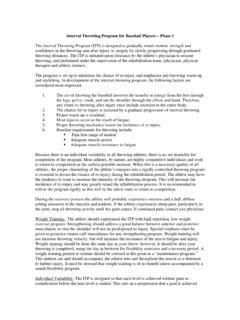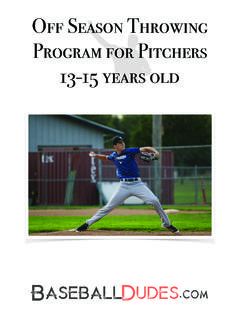Transcription of Interval Throwing Program for Baseball Players – Phase I
1 Interval Throwing Program for Baseball Players Phase I. The Interval Throwing Program (ITP) is designed to gradually return motion, strength and confidence in the Throwing arm after injury or surgery by slowly progressing through graduated Throwing distances. The ITP is initiated upon clearance by the athlete's physician to resume Throwing , and performed under the supervision of the rehabilitation team, (physician, physical therapist and athletic trainer). The Program is set up to minimize the chance of re-injury and emphasize pre- Throwing warm-up and stretching. In development of the Interval Throwing Program , the following factors are considered most important. 1. The act of Throwing the Baseball involves the transfer or energy from the feet through the legs, pelvis, trunk, and out the shoulder through the elbow and hand.
2 Therefore, any return to Throwing after injury must include attention to the entire body. 2. The chance for re-injury is lessened by a graduate progression of Interval Throwing . 3. Proper warm-up is essential. 4. Most injuries occur as the result of fatigue. 5. Proper Throwing mechanics lessen the incidence of re-injury. 6. Baseline requirements for Throwing include: Pain-free range of motion Adequate muscle power Adequate muscle resistance to fatigue Because there is an individual variability in all Throwing athletes, there is no set timetable for completion of the Program . Most athletes, by nature, are highly competitive individuals and wish to return to competition at the earliest possible moment. While this is a necessary quality of all athletes, the proper channeling of the athlete's energies into a rigidly controlled Throwing Program is essential to lessen the chance of re-injury during the rehabilitation period.
3 The athlete may have the tendency to want to increase the intensity of the Throwing Program . This will increase the incidence of re-injury and may greatly retard the rehabilitation process. It is recommended to follow the Program rigidly as this will be the safest route to return to competition. During the recovery process the athlete will probably experience soreness and a dull, diffuse aching sensation in the muscles and tendons. If the athlete experiences sharp pain, particularly in the joint, stop all Throwing activity until this pain ceases. If continued pain, contact you physician. Weight Training: The athlete should supplement the ITP with high repetition, low weight exercise Program . Strengthening should address a good balance between anterior and posterior musculature so that the shoulder will not be predisposed to injury.
4 Special emphasis must be given to posterior rotator cuff musculature for any strengthening Program . Weight training will not increase Throwing velocity, but will increase the resistance of the arm to fatigue and injury. Weight training should be done the same day as your throw: however, it should be after your Throwing is completed, using the day in between for flexibility exercises and a recovery period. A. weight training pattern or routine should be stressed at this point as a maintenance Program .. This pattern can and should accompany the athlete into and throughout the season as a deterrent to further injury. It must be stressed that weight training is of no benefit unless accompanied by a sound flexibility Program . Individual Variability: The ITP is designed so that each level is achieved without pain or complication before the next level is started.
5 This sets up a progression that a goal is achieved prior to advancement instead of advancing to a specific timeframe. Because of this design, the ITP may be used for different levels of skills and abilities from those in high school to professional levels. The reason for being in the ITP will vary from person to person. Example: One athlete may wish to use alternate days Throwing with or without using weights in between;. another athlete may have to throw every third or fourth day due to pain or swelling. Listen to your body it will tell you when to slow down. Again, completion of the steps of the ITP will vary from person to person. There is no set timetable in terms of days to completion. Warm-up: Jogging increases blood flow to the muscles and joints thus increasing their flexibility and decreasing the chance of re-injury.
6 Since the amount of warm-up will vary from person to person, the athlete should jog until developing a light swear, then progress to the stretching Phase . Stretching: Since Throwing involves all muscles in the body, all muscle groups should be stretched prior to Throwing . This should be done in a systematic fashion beginning with the legs and including the trunk, back, neck and arms. Continue with capsular stretches and L-bar range of motion exercises. Throwing Mechanics: A critical aspect of the ITP is maintenance of proper Throwing mechanics throughout the advancement. The use of the Crow-Hop method simulates the Throwing act, allowing emphasis of the proper body mechanics. This Throwing method should be adopted from the set of the ITP. Throwing flat footed encourages improper body mechanics, placing increases tress on the Throwing arm and, therefore, predisposing the arm to re-injury.
7 The pitching coach and sports biomechanicianist (if available) may be valuable allies to the rehabilitation team with their knowledge of Throwing mechanics. Components of the Crow-Hop method are first a hop, then a skip, followed by the throw. The velocity of the throw is determined by the distance, whereas the ball should have only enough momentum to travel each designed distance. Throwing : Using the Crow-Hip method, the athlete should begin warm-up throws at a comfortable distance (approximately 30-45 ft.) and then progress to the distance indicated for that Phase (refer to Table 1). The Program consists of Throwing at each step 2 to 3 times without pain or symptoms before progressing to the next stop. The object of each Phase is for the athlete to be able to throw the ball without pain the specified number of feet (45 ft.)
8 , 60 ft., 90 ft., 120 ft., 150. ft., 180 ft.), 75 times at each distance. After the athlete can throw at the prescribed distance without pain they will be ready for Throwing from flat ground 60ft/. 6 in. in the normal pitching mechanics or return to their respective position (step 14). At this point, full strength and confidence should be restored in the athlete's arm. It is important to stress the Crow-Hop method and proper mechanics with each throw. Just as the advancement to this point has been gradual and progressive, the return to unrestricted Throwing must follow the same principles. A pitcher should first throw only fast balls at 50%, progressing to 75% and 100%. At this time, he may start more stressful pitches such as breaking balls. The position player should simulate a game situation, again progressing at 5-75-100%.
9 Once again, if an athlete has increased pain, particularly at the joint, the Throwing Program should be backed off and re-advanced as tolerated, under the direction of the rehabilitation team. Batting: Depending on the type of injury that the athlete has, the time of return to batting should be determined by the physician. Is should be noted that stress placed upon the arm and shoulder in the batting motion are very different from the Throwing motion. Return to unrestricted use of the bat should also follow the same progression guidelines as seen in the training Program . Begin with dry swings progressing to hitting off the tee, hen soft toss and finally live pitching. Summary: In using the Interval Throwing Program (ITP) in conjunction with a structured rehabilitation Program , the athlete should be able to return to full competition status, minimizing any chance of re-injury.
10 The Program and its progression should be modified to meet the specific needs of each individual athlete. A comprehensive Program consisting of maintenance strength and flexibility Program , appropriate warm-up and cool down procedures, proper pitching mechanics, and progressive Throwing and batting will assist the Baseball player in returning safely to competition. 45' Phase 60' Phase 90' Phase 120' Phase Step Step Step 1: A) Warm-up Throwing 3: A) Warm-up Throwing 5: A) Warm-up Throwing Step 7: A) Warm-up Throwing B) 45' (25 Throws) B) 60' (25 Throws) B) 90' (25 Throws) B) 120' (25 Throws). C) Rest 5-10 min. C) Rest 5-10 min. C) Rest 5-10 min. C) Rest 5-10 min. D) Warm-up Throwing D) Warm-up Throwing D) Warm-up D) Warm-up Throwing E) 45' (25 Throws) E) 60' (25 throws) E) 90' (25 Throws) E) 120' (25 Throws).


